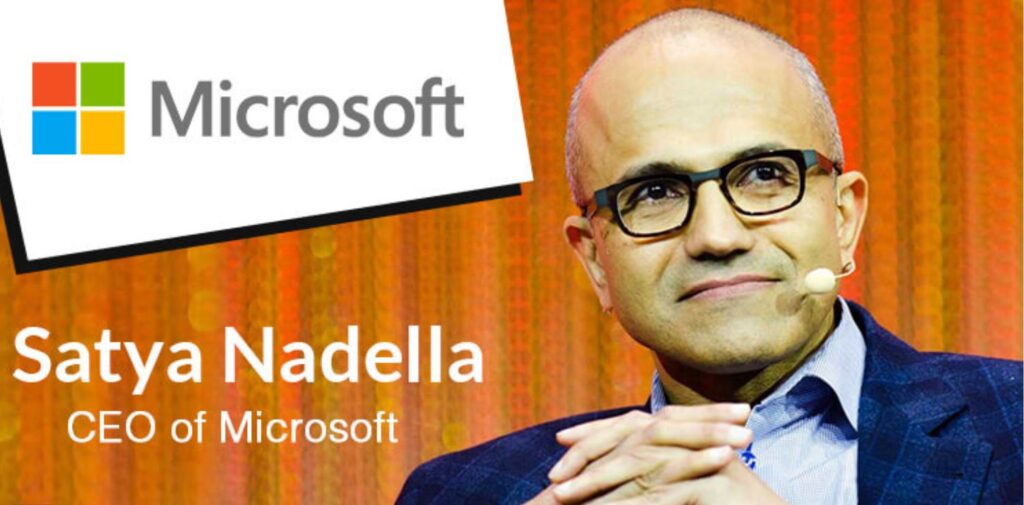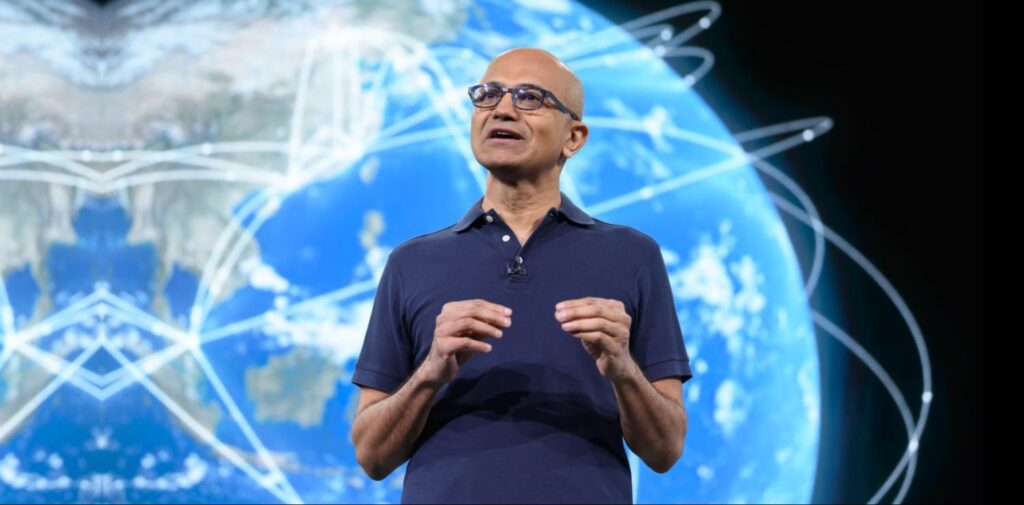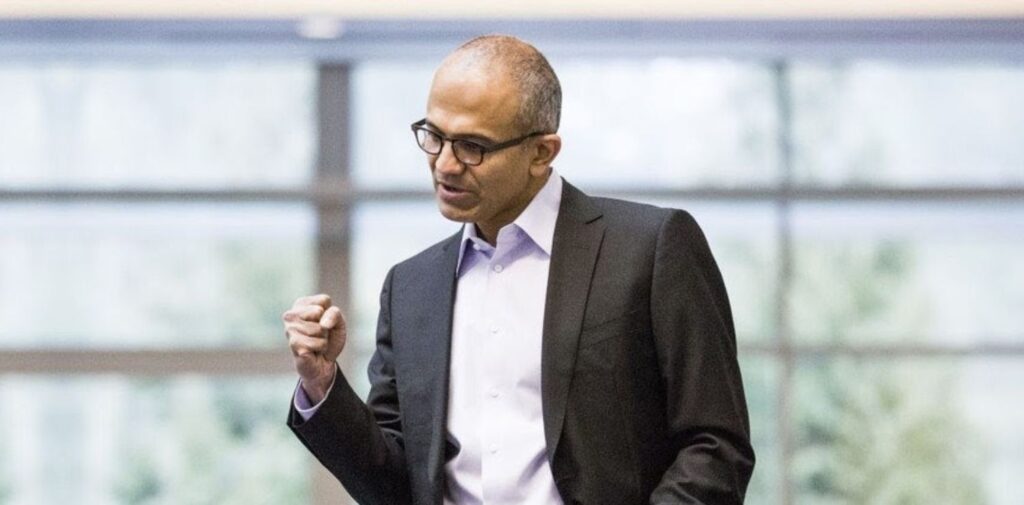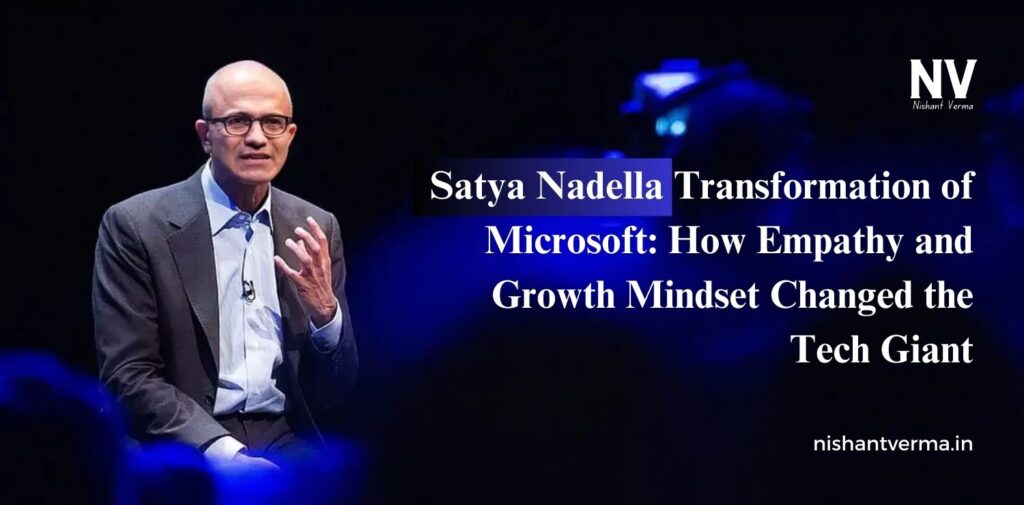In 2014, when Satya Nadella took over as the CEO of Microsoft, the company was at a crossroads. The once-dominant force in personal computing, known for its Windows operating system and office productivity software, was facing serious challenges. Microsoft had lost its way in mobile phones, its innovation seemed to be slowing down, and it was struggling to remain relevant in a world shifting toward cloud computing and artificial intelligence.
Nadella, however, took a different approach—one that would not only reshape Microsoft but also redefine the company’s values and culture. His leadership introduced empathy, collaboration, and a growth mindset, all of which played a significant role in transforming the tech giant. This transformation was not just about products and profits; it was about people, culture, and leadership in the digital age.
The Rise of Satya Nadella: A Leader with a Vision
Before becoming CEO, Satya Nadella had worked at Microsoft for over two decades. He started his career as an engineer and steadily moved up the ranks, heading some of the company’s most critical divisions, such as Cloud and Enterprise. This hands-on experience in various technical fields gave him a deep understanding of how technology could drive change, but it also made him acutely aware of the need for a new approach to leadership.
Nadella came into power at a time when Microsoft needed a transformation. His predecessor, Steve Ballmer, had overseen the company during a period of massive growth, but also one of stagnation in key areas. Under Ballmer, Microsoft struggled with its response to the rise of smartphones, cloud computing, and open-source technologies. Nadella’s appointment marked the beginning of a shift in both vision and strategy.

A Culture of Empathy: Changing the Internal Landscape
One of the first things Nadella focused on when he became CEO was Microsoft’s internal culture. The company had become known for its intense, competitive work environment. Employees were often encouraged to outdo each other, and this led to a siloed, fragmented culture. Nadella believed that for Microsoft to truly innovate and grow, its people needed to feel empowered, collaborative, and supported.
He began by promoting a culture of empathy—where employees were encouraged to understand and respect each other’s perspectives. This focus on empathy wasn’t just a feel-good initiative; it was a strategic decision to help the company work better together. Nadella emphasized that empathy was not just about kindness or emotional connection, but about truly understanding the challenges faced by others, whether they were customers, employees, or partners.
The Power of a Growth Mindset
Perhaps one of the most influential changes that Satya Nadella brought to Microsoft was the idea of the “growth mindset.” This concept, popularized by psychologist Carol Dweck, holds that intelligence and talent are not fixed traits but can be developed through hard work, learning, and perseverance.
Nadella made the growth mindset a cornerstone of Microsoft’s corporate philosophy. He encouraged employees to embrace failure as part of the learning process, rather than fearing it. The goal was to build a culture where people could experiment, take risks, and learn from their mistakes. This shift was essential for fostering innovation and agility, which are critical for a tech company in the rapidly evolving digital world.
By introducing the growth mindset, Nadella transformed how Microsoft’s teams approached problem-solving. Employees were no longer focused solely on avoiding mistakes or preserving the status quo; instead, they were encouraged to learn from failures and continuously improve. This mindset change helped Microsoft to innovate faster and take bold steps in new areas like cloud computing and artificial intelligence.

Shifting Microsoft’s Strategy: Cloud Computing and AI
Nadella’s vision for Microsoft was clear: the future of technology lay in the cloud. While the company had initially been slow to embrace this shift, Nadella quickly recognized the transformative potential of cloud technology. Under his leadership, Microsoft made a bold pivot toward cloud services through its Azure platform, a move that has since paid off tremendously.
The growth of Azure turned out to be one of the most significant achievements of Nadella’s tenure as CEO. Today, Azure is one of the top cloud platforms globally, competing directly with Amazon Web Services (AWS). But Nadella didn’t just invest in infrastructure; he made sure that Microsoft’s entire product line was built around the cloud. Office 365, Microsoft Teams, and even the company’s developer tools became cloud-first products.
Nadella’s embrace of artificial intelligence (AI) also aligned with his broader strategy of leveraging cutting-edge technologies to drive growth. Microsoft’s AI investments led to breakthroughs in areas like natural language processing, machine learning, and computer vision. Under Nadella’s leadership, Microsoft also acquired LinkedIn and GitHub, extending its reach into professional networking and developer communities.
Putting People First: A Focus on Diversity and Inclusion
A significant part of Satya Nadella’s leadership philosophy is his emphasis on diversity and inclusion. He recognized that diverse teams are more innovative, and that fostering a culture where everyone feels respected and valued would lead to better outcomes for both the company and its customers.
Nadella has been outspoken about the need to close the gender gap in tech, and he made significant strides in increasing the representation of women and minorities at Microsoft. He created programs to attract diverse talent, promote women in leadership positions, and ensure that underrepresented groups had a seat at the table.
One of the ways Nadella showcased his commitment to diversity was through his own personal transformation. He has been open about his journey toward understanding the importance of empathy, especially after the birth of his son, Zain, who was born with cerebral palsy. This experience deepened his understanding of the challenges faced by people with disabilities, and it fueled his commitment to making Microsoft a more inclusive company. This not only shaped the company’s products but also influenced its workplace culture.
Emphasizing Collaboration and External Partnerships
Under Nadella, Microsoft also shifted from a “one-giant” mentality to a more collaborative approach, not just internally but externally with other tech giants and businesses. This was in stark contrast to Microsoft’s previous, more combative posture toward competitors.
Nadella’s leadership saw Microsoft collaborating with its rivals in unprecedented ways. For example, the company began integrating its Office 365 applications with Google’s Android and Apple’s iOS, and even partnered with Linux-based open-source communities. This marked a sharp departure from the company’s former stance, where it often viewed other companies as competitors to be crushed. Nadella understood that in the modern tech landscape, collaboration was more important than competition.

Achievements Under Nadella: A New Era of Success
The results of Nadella’s leadership were undeniable. Under his guidance, Microsoft’s stock price soared, and the company became the second-largest company in the world by market value, only behind Apple. Nadella’s focus on the cloud and AI paid off, with Microsoft becoming a leader in both areas.
Additionally, Microsoft’s culture of empathy, innovation, and growth mindset has had a lasting impact on the tech industry as a whole. Companies worldwide have begun to adopt some of the principles that Nadella championed—creating more inclusive, collaborative, and learning-oriented environments.
One of the key lessons from Satya Nadella’s transformation of Microsoft is that great leadership is not just about making smart business decisions; it’s about understanding people, embracing change, and fostering a culture where growth, empathy, and collaboration thrive.
Conclusion: The Power of Empathy and Growth
Satya Nadella’s transformation of Microsoft teaches us an important lesson: success is not just about what you do, but how you do it. It is about understanding people, embracing challenges, and never stopping the learning process. Nadella’s focus on empathy, a growth mindset, and collaboration turned Microsoft from a company that was struggling to adapt into one that now leads in several of the most important technological fields.
In today’s fast-paced world, where technology and business landscapes are constantly shifting, Satya Nadella’s leadership offers a powerful example. It shows that even in the most challenging times, success can be achieved by focusing on what truly matters—people, culture, and growth.




